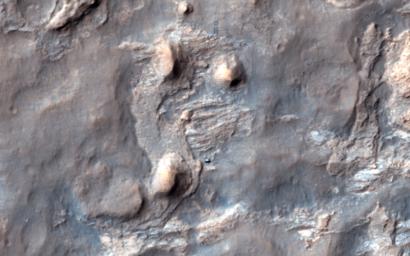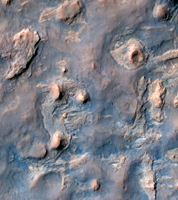
|
Curiosity Ready to Drill for Gold at the Kimberley
- Click the image above for a larger view
- Full-Res JPEG (2880 x 1800) (735.3 kB)
- Full-Res TIFF (2880 x 1800) (15.6 MB)
Caption:

Map Projected Browse Image
Click on the image for larger version
Black gold, that is: organic material, which could be a biomarker (sign of past life), the holy grail of Mars exploration.
Last December at the fall meeting of the American Geophysical Union in San Francisco, MSL Project Scientist John Grotzinger talked about what the team learned at Yellowknife Bay, and why they would stop and drill again at a place named "the Kimberley."
The mudstones at Yellowknife Bay had been exposed recently -- to a geologist -- less than 100 million years ago. They deduced that this was due to erosion of overlying layers by the wind, and that even younger exposure ages should be possible closer to the scarp.
This matters because Mars doesn't have a magnetosphere and thick atmosphere like Earth, protecting us from energetic particles from space that break down organic material. Thus, rocks that have been near the surface of Mars for a long time (geologically speaking) are less likely to contain complex organic material. Complex organic material might be the remains of past life, or at least inform us about past habitability. And when we say "habitability," we mean the potential to support life, whether or not life ever actually existed there.
The rover had left Yellowknife Bay and wasn't going to turn around, but similar scarps lay ahead, on the way to Aeolis Mons. Last December they had already chosen their next target-the Kimberley-where they recently arrived, in part because it also has what appear to be geologically young scarps. This new HiRISE image shows the rover approaching one of the scarps. (See also PIA18082 , the stereo anaglyph of this site produced from this image by Tim Parker at JPL, and PIA18081 .)
Background Info:
HiRISE is one of six instruments on NASA's Mars Reconnaissance Orbiter. The University of Arizona, Tucson, operates the orbiter's HiRISE camera, which was built by Ball Aerospace & Technologies Corp., Boulder, Colo. NASA's Jet Propulsion Laboratory, a division of the California Institute of Technology in Pasadena, manages the Mars Reconnaissance Orbiter Project for the NASA Science Mission Directorate, Washington.
Cataloging Keywords:
| Name | Value | Additional Values |
|---|---|---|
| Target | Mars | |
| System | ||
| Target Type | Planet | |
| Mission | Mars Reconnaissance Orbiter (MRO) | Mars Science Laboratory (MSL) |
| Instrument Host | Mars Reconnaissance Orbiter | Curiosity Rover |
| Host Type | Orbiter | Rover |
| Instrument | High Resolution Imaging Science Experiment (HiRISE) | |
| Detector | ||
| Extra Keywords | Atmosphere, Color, Magnetosphere, Map, Mountain | |
| Acquisition Date | ||
| Release Date | 2014-04-16 | |
| Date in Caption | ||
| Image Credit | NASA/JPL-Caltech/Univ. of Arizona | |
| Source | photojournal.jpl.nasa.gov/catalog/PIA18227 | |
| Identifier | PIA18227 | |
